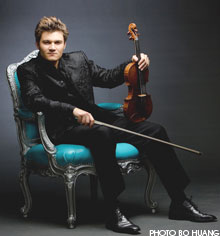Alexander Da Costa: A passion for recordings by Caroline Rodgers
/ December 1, 2011
Version française...
Flash version here.
 At only 31 years old, violinist Alexandre
Da Costa has already recorded his sixteenth CD. This fall, he released
Fire and Blood, his first recording with the MSO and his first collaboration
with Warner Classics. It also marked the occasion of the Quebec launch
of the new record label Acacia, a cooperative formed by Da Costa and
other musicians. At only 31 years old, violinist Alexandre
Da Costa has already recorded his sixteenth CD. This fall, he released
Fire and Blood, his first recording with the MSO and his first collaboration
with Warner Classics. It also marked the occasion of the Quebec launch
of the new record label Acacia, a cooperative formed by Da Costa and
other musicians.
The violinist freely admits that
Fire and Blood has become one of his favourite recordings, which
he hopes will be heard by a large audience. When he discovered this
concerto, he quickly phoned the composer. Michael Daugherty, to tell
him he wanted to record it. Since then, whenever a conductor has contacted
him to play with an orchestra, Da Costa has tried to get Fire and
Blood on the program.
“I wanted this concerto to be the
first that I recorded with Warner,” he said. “It’s written in
a modern style but is easily approachable. It’s tonal, understandable,
and incorporates elements of Mexican and folk music. It falls somewhere
between film and contemporary music and is a good introduction to modern
music for neophytes. In my opinion, this is a good direction to explore
for contemporary music. In concert, it’s very successful. People go
home with the same enthusiasm as if they had heard a work they’ve
known for a long time, like Tchaikovsky’s concerto.”
Alexandre Da Costa feels at home
in the world of recordings. “I’ve been lucky to have people around
me who deeply love recorded music and who have communicated their passion
to me, for example Johanne Goyette of ATMA,” he explains.
For him, CD recordings are an essential
element in a musician’s career. “They serve as markers over the
long term,” he said. “Concerts are the most important, but a concert
is ephemeral, whereas a disc lasts your whole life. A recording shows
the point you had reached as a musician at a particular time. When I
listen to my first recording of the Tchaikovsky concerto from when I
was 17, I could swear that it’s not me at all! I will definitely record
it again sometime, having reached a stage where I’ve evolved enough
musically to revisit works I’ve already recorded.”
Motivated by his passion for recordings,
and wanting to ensure the success of his beloved Fire and Blood
in Quebec, Da Costa was spurred to launch the new Acacia record label.
Pianist Wonny Song and conductor Jean-François Rivest, among others,
have joined him in this venture.
“Our intention is to produce only
four or five discs per year, but these will be high quality, hand-picked
projects,” he says.
Worldwide, Fire and Blood
is on the Warner Classics label, with which the violinist has signed
a two-year contract.
“It was they who allowed this project
to see the light of day,” he says. “But I convinced them that for
Quebec, it was preferable to have a local label. For Warner, Quebec
is a very small market, and for that reason they wouldn’t necessarily
have invested a lot of effort in promoting the disc. Whereas we have,
in Quebec, specialized labels like ATMA and Analekta doing excellent
work. Furthermore, most of the classical discs sold in Canada are sold
in Quebec. If we do the promotion ourselves, we do a better job, even
more so because for distribution we have the Universal machine behind
us.”
He even insisted that the disc be
recorded here, in Montreal, with the MSO. The recording took place in
concert in November 2009, under the direction of Spanish conductor Pedro
Halffter. The CD features two other works by Michael Daugherty: Flamingo,
for orchestra, and Ladder to the moon, a concerto for solo violin,
wind octet, double bass and percussion.
Translation: Rona Nadler
|
Michael Daugherty
discusses his work |
In composing
Fire and Blood, Michael Daugherty was inspired by the Detroit
Industry murals of Mexican painter Diego Rivera, which represent
the auto industry in Detroit in the thirties. “They inspired me to
create my own musical fresco for violin and orchestra,” he comments
in the CD liner notes.
On a musical level, he worked with violinists from different musical
universes for inspiration, he explained to LSM in a phone interview.
“I listened to classical, jazz, bluegrass and mariachi violinists
in order to explore all the parameters of the instrument. I used musical
ornamentation evoking Mexican music. I see my work as a composer a bit
like that of a film director. If you directed a film on the life of
Diego Rivera and Frida Kahlo, you wouldchoose costumes that are typical
of their country and their time. This was my guiding principle. I think
that this is the kind of work one must do to write a concerto that stands
out.” |
Version française... |
|


